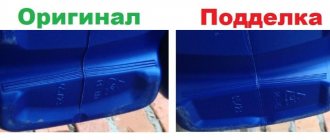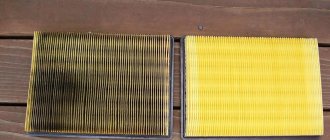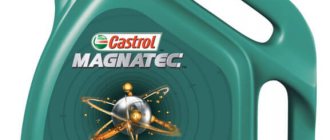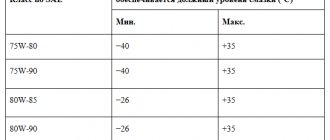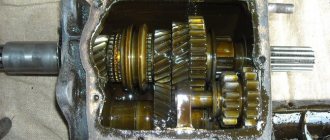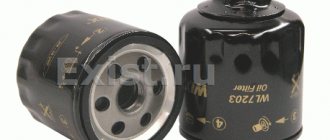Mirror-video recorder FUGICAR FC8
Sun blinds Trokot with magnets!!!
For most modern gasoline and diesel internal combustion engines, the technical characteristics of 5W30 oil are optimal. This product is designed to lubricate components and parts, remove excessively high temperatures inside the unit, and also minimize the effects of friction of moving and stationary parts. Selecting a product is quite simple; manufacturers offer many options for such oil.
To ensure long-term and efficient operation of such a complex mechanism as an internal combustion engine, it is important to provide it with high-quality care. The motor consists of many individual parts that operate under extreme temperature loads and constant friction. All this inevitably leads to gradual wear and tear of the power unit.
In order for the engine to work as long as possible and not cause any problems to the car owner during operation, it is important to provide high-quality care and regularly refill the lubrication system with 5W30 engine oil.
Explanation of the 5W30 marking
First of all, it should be noted that marking, which allows you to quickly determine the main characteristics of a lubricant, is carried out according to the generally accepted international SAE classification.
In accordance with this standard, for 5W30 motor oil, the first number “5” indicates the viscosity at low temperatures, and the second “30” indicates the fluidity parameter at low temperatures.
The product is all-season, which is why it is extremely popular among motorists. In fact, the versatility of the oil indicates its suitability for use in engines running on different types of fuel. And the temperature range of application covers almost all climatic zones of our country.
Quality classification
Most 5W30 motor oils have technical characteristics in terms of ash content, anti-friction and anti-wear properties, sulfur and phosphorus content, among others, that allow them to be considered among the highest quality. In the commonly used API classification system, this means assigning them the highest quality classes currently in effect.
The API system involves assigning classes to oils, dividing them into groups S (gasoline) and C (diesel). Since universal-type oils are the most popular for passenger vehicles, both quality classes are indicated for them, and accordingly, certification tests are carried out using both methods. The principle of numbering standards in the order of their adoption is simple - the Latin alphabet is used. For gasoline engines, the latest standard adopted is API SN, which replaced API SM, adopted at the end of 2004.
For diesel engines, in addition to the quality class index, the engine cycle is also indicated, if this is relevant within the framework of this standard. Thus, API CF-4 oil is intended only for four-stroke diesel engines, while the suffix “-2” would indicate use in two-stroke cycle diesel engines.
Additionally, the quality class is indicated according to the European ACEA standard, which takes into account the specifics of European environmental standards and relevant requirements for the composition and properties of motor oils. For gasoline and diesel cars, quality classes are designated by indices A and B, respectively, numbered in order of adoption, but class C is also especially highlighted for engines made to environmental standards Euro 4 and higher. The presence of an oil that complies with one of the quality classes of this ACEA group is important, first of all, when selecting lubricants for engines with particulate filters and multi-component catalysts.
More details about the characteristics, decoding features
The quality of the lubricant is directly influenced by 2 main parameters: viscosity when exposed to negative and positive ambient temperatures.
Let's consider them sequentially:
- Low temperature viscosity.
The parameter is important for the engine of any car, since it is this parameter that shows whether the lubricant is capable of remaining on the surface of the parts for a long time. This property of the substance is encrypted as “5W”, where the letter indicates the possibility of use in winter conditions:
W–winter. It is known that at low TC values, oil, as well as other liquids, thicken.
- High temperature viscosity.
The parameter specifies the other half of the label. Thus, in accordance with the established SAE classification for a given brand of oil at a temperature of 100ºС, the viscosity index will be in the range of 9.3 - 12.6 mm kV/s. Another parameter that characterizes high-temperature properties is the minimum viscosity at shear rate (106 s-10. For this product, this parameter does not exceed 2.9.
Once you understand the parameters, you can decipher 5WЗ0 engine oil easily and quickly.
Types of oils
Lubricants in the automotive market are represented in three categories:
- For gasoline engines.
- For diesel engines.
- Universal. Designed for both diesel and gasoline internal combustion engines.
You may be interested in: How to remove underlining from links? CSS property text-decoration
Oils, depending on the season of use, are divided into three types:
- Summer.
- Winter - 5W and 10W.
- All-season - 0W30 and 5W30.
The effectiveness of motor oil depends on its physical properties, one of which is viscosity. It ensures the ability of the lubricant to remain on the surface of parts and maintain its fluidity. The parameter affects the protection of the engine from premature wear and friction during vehicle operation. If the declared viscosity does not correspond to that recommended by the manufacturer, the service life of the motor may be reduced.
You may be interested in: Redirect: what is it and how to remove it from the browser?
High-temperature viscosity is an equally important parameter, non-compliance with which may lead to the need for early major repairs due to engine operation at high speeds beyond permissible limits.
When choosing a lubricant, the viscosity indicator is taken into account - it must correspond to the parameters recommended by the manufacturer. Using engine oil that differs from the required requirements can cause engine failure and costly repairs.
Features of practical application
When deciding to use a particular product in the lubrication system, you need to understand that for cars with different years of production, experts give individual recommendations on the choice of oil. As for the 5W 30 brand, it should be used if the vehicle's service life is more than 7 years, and the mileage has not exceeded 70 thousand km. If these indicators are exceeded, you should use oil with a higher high-temperature viscosity: 5W40.
When choosing 5W30 oil, in addition to the degree of engine wear and service life, you should pay attention to the following indicators:
- Type of power unit;
- How intensively the vehicle is used;
- Features of road and climatic conditions;
- The presence of additives that improve the physical, mechanical and operational properties of the product.
Selection of 5W30 oils
The car manufacturer indicates the technical characteristics that are relied upon when choosing engine oil. Lubricant approvals are based on engine type, not vehicle make and model. For this reason, the selected engine oil must meet the requirements set by the automaker.
The choice of 5W30 synthetic by decoding depends on the characteristics of the engine, the age of the car and the characteristics of the operating conditions. For cars older than 5-7 years, mineral motor oil is better suited, since its use reduces lubricant consumption and increases the service life of the power unit.
Synthetic oils are recommended for new generation foreign-made engines. The interpretation of 5W30 SN indicates that such a product is optimal for foreign cars operating in urban areas.
Advantages and disadvantages
Fully synthetic oil has excellent technical characteristics. 5W30 oil is ideal for cars operated in city driving conditions, when exposed to fairly aggressive external factors.
Motor oils of the 5W30 series have unique properties that are ensured by the introduction of a special multicomponent additive into the product composition.
These additives provide the highest level of enhanced protection of the power unit from premature wear, including:
- Anti-corrosion resistance;
- Resistance to oxidative processes;
- Excellent cleaning properties;
- High moisture release rates.
After pouring 5W30 oil into the lubrication system, a durable film that is resistant to various types of loads is formed on all moving and stationary parts of the engine. It provides the highest level of protection of parts from all kinds of loads.
And a fairly high level of viscosity is finely balanced with fluidity indicators. The result is that the power unit is reliably protected both during cold starts at low subzero temperatures and during operation at maximum load.
All of the above characteristics have ensured 5W30 fully synthetic motor oil increased popularity among a wide range of motorists. If used correctly, following the manufacturer's recommendations and observing all the basic application parameters, 5W30 oil has no disadvantages. Just like analogues!
How oils are classified by origin
Depending on the chemical composition, as well as the method of manufacturing the base, lubricants are divided into a couple of broad subgroups - mineral and synthetic. Mineral oil liquid is made from petroleum through distillation. Synthetic is produced through organic synthesis, also petroleum-based, but with more complete processing of the base substance.
There are also semi-synthetic lubricants. Semi-synthetics are made by adding synthetic elements to mineral oil. Semi-synthetics is not an entirely correct name; it would be more correct to say “mineral with added synthetic elements.”
Benefits of 5W-30 oils
5W-30 is a synthetic motor oil that is most popular among modern motorists. It has become very widespread among cars that are used in urban environments. Using this lubricant, it is possible to prevent the negative impact of the following factors on the engine:
- Frequent and prolonged traffic jams.
- Long idle operation of the engine.
- Excessive dust content.
- Frequent short trips.
Motor oil 5W-30 is a unique liquid that is equipped with specific additives. They protect the internal surface of the engine from excessive wear. Typically, this oil is changed once every 20-30 thousand kilometers.
Strengths of motor oil
SAE 30 motor oil from reputable brands, as a rule, has the following properties:
- Remarkable lubricity, regardless of driving style.
- Reliable protection, reduced engine wear, and prevention of deposits even during extreme driving.
- Protection at elevated temperatures, ensuring favorable conditions for long-term operation of a turbocharged engine.
- High-quality cleaning of dirty motors.
- Good lubrication at cold tolerances and protection at sub-zero temperatures.
Selection of oil according to all rules
Correct selection of lubricant consists of knowing certain abbreviations that carry important information for the driver. Among them:
1. SAE (USA Association of Automotive Engineers). The SAE 5w 30 oil described here also belongs to this classification. This designation helps car owners make selections based on climate.
On the back of the container with engine oil there is data on the SAE classification, thanks to which it is possible to find out at what temperature the oil product should be used.
It is very important for drivers to understand such subtleties, because in such a large country as Russia, severe frosts occur in some regions, while in others there is intense heat for months. The exact decoding of SAE suggests that the digital increase will serve as a hint that the lubricant is recommended for elevated temperatures.
For 5w30 oil, the decoding states that the maximum operating temperature is +25ºС. So, this oil product is recommended for use in the temperature range from -30ºС to +25ºС. In regions where summer temperatures do not rise above +25ºС, SAE 5w30 grease can be considered all-season.
Also read: Oil viscosity - what the numbers mean
2. Oil marked High Temperature means that this lubricant will help reduce fuel consumption, that is, it is energy saving. Grease with this mark is used in conditions with elevated temperatures.
3 . The abbreviation ISLAC indicates that the oil is manufactured according to the standards of the international committee (Japan, USA).
4. Selecting oil according to the ACEA (for diesel and gasoline engines) reduces the risk of needing engine overhauls.
Types of motor oils
The oil, known as synthetic, has a base obtained through the synthesis of chemicals. The main characteristic features of “synthetics” are the ability to set some parameters in advance at the stage of creating a lubricant.
This type also includes the largest number of additives. That is why “synthetics” guarantee excellent protection and cleaning properties. It does not thicken at sub-zero temperatures and is resistant to maximum operating conditions.
A test of 5w30 synthetic motor oils showed their following capabilities:
- wide operating temperature range;
- stable operation at high pressure;
- resistance to polymerization;
- cleaning qualities;
- excellent viscosity;
- low volatility.
If we talk about the disadvantages of synthetic lubricants, they are increased chemical activity caused by the presence of a large number of additives and low compatibility with mineral oils.
The mineral is obtained from petroleum. This product is inexpensive, but inferior to its synthetic counterpart in some aspects. In comparison with “synthetics”, “mineral water” is inferior in the following factors:
- does not provide high performance results;
- does not withstand too high temperatures;
- thickens in extreme cold;
- prone to rapid oxidation;
- needs to be replaced after boiling;
- forms sludge in the engine.
An oil that is a cross between synthetic and mineral is known as “semi-synthetic”. This oil product is made on a mineral basis, to which a lot of additives are added, allowing the semi-synthetic oil to come as close as possible to synthetics. Having a number of strengths, “semi-synthetics” are cheaper than “synthetics”.
Also read: Which oil is better: 5w30 or 5w40 in winter?
Oil that meets the standard
The SAE oil classification allows you to understand how thick or thin a lubricant is. To ensure that the lubricant meets Society of Automotive Engineers standards, experts conduct a test.
When filling the engine with oil, make sure that the lubricant sufficiently fills the large gaps between the elements in contact with each other and does not drain and is able to maintain the pressure optimal for the functioning of the system.
The flow rate is determined by the amount of time it takes for the lubricant to completely flow through a calibrated hole. The higher the density of the material, the longer it will take to flow.
It is known that a lubricant that is too thin will not be able to sufficiently lubricate the system and will be subject to rapid evaporation under the influence of high temperatures.
But if the lubricant is very thick, it will be difficult to start the car when the thermometer is minus. That is why you need to select based on the recommendations of the car manufacturer, which indicates the appropriate class of oil product in the car’s operating instructions.
SAE 30 grease is considered suitable for new vehicles that have reached less than 25% of their engine life. In this case, the specified oil can be used as an “all-season” oil. It is also suitable for cars that have already used up 2 to 3 quarters of their allotted engine life. In this case, 5W30 oil is recommended for use in the summer.
By paying close attention to the needs of the engine and the operation of the lubrication system, you can really extend the life of your car by years and avoid annoying breakdowns.
Oil test 5W-30
Before a motor oil receives its quality certificate, it must undergo comprehensive testing. It is based on chemical analysis. You can obtain information about the tests performed from the label - it should contain detailed information about the results obtained. Also on the label, each manufacturer places compliance with the declared standards. Oil testing is carried out in laboratories; special stands are used for this.
It is very important to study at what temperatures engine oil retains its performance properties. In addition, such tests allow you to determine whether the engine can be started in cold weather. The tests also show whether the oil forms a protective film on the surface of the parts. With its presence, it is possible to significantly increase the service life of the power unit. A good oil also contains detergent components.
